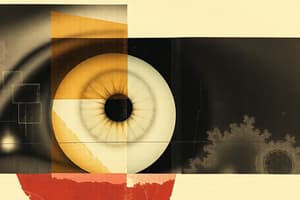Podcast
Questions and Answers
How is hyperopia typically corrected?
How is hyperopia typically corrected?
- Through medication to improve visual acuity.
- Wearing convex lenses with a power equal to the degree of hyperopia. (correct)
- Wearing concave lenses with a power equal to the degree of hyperopia.
- Using cylindrical lenses for regular astigmatism.
Which type of astigmatism has one focal point that falls on the retina?
Which type of astigmatism has one focal point that falls on the retina?
- Simple astigmatism (correct)
- Mixed astigmatism
- Compound astigmatism
- Myopic astigmatism
What distinguishes irregular astigmatism from regular astigmatism?
What distinguishes irregular astigmatism from regular astigmatism?
- Regular astigmatism has irregular curvature with no specific pattern. (correct)
- Irregular astigmatism has a predictable curvature of the cornea.
- Regular astigmatism is caused by trauma or burns.
- Irregular astigmatism occurs only due to congenital conditions.
In which scenario would one use spherocylindrical glasses for correction?
In which scenario would one use spherocylindrical glasses for correction?
What is a characteristic of mixed astigmatism?
What is a characteristic of mixed astigmatism?
What is the primary characteristic of a stigmatic optical system?
What is the primary characteristic of a stigmatic optical system?
Which type of ametropia maintains the symmetry of revolution with spherical diopters?
Which type of ametropia maintains the symmetry of revolution with spherical diopters?
In the case of myopia, the image of an object at infinity forms where in relation to the retina?
In the case of myopia, the image of an object at infinity forms where in relation to the retina?
How is myopia corrected for spectacles?
How is myopia corrected for spectacles?
What does an emmetropic eye exemplify?
What does an emmetropic eye exemplify?
What is the degree of myopia expressed as?
What is the degree of myopia expressed as?
In hyperopia, where does the image of an object at infinity form in relation to the retina?
In hyperopia, where does the image of an object at infinity form in relation to the retina?
Which of the following is a characteristic of astigmatism?
Which of the following is a characteristic of astigmatism?
Flashcards
Stigmatic Optical System
Stigmatic Optical System
A point object produces a clear point image.
Astigmatic Optical System
Astigmatic Optical System
A point object produces a blurred image.
Accommodation
Accommodation
The ability of the eye to focus on objects at different distances. It is achieved by changing the shape of the lens.
Emmetropic Eye
Emmetropic Eye
Signup and view all the flashcards
Ametropic Eye
Ametropic Eye
Signup and view all the flashcards
Myopia
Myopia
Signup and view all the flashcards
Hyperopia
Hyperopia
Signup and view all the flashcards
Power of a Dioptre
Power of a Dioptre
Signup and view all the flashcards
What is Astigmatism?
What is Astigmatism?
Signup and view all the flashcards
What is Simple Astigmatism?
What is Simple Astigmatism?
Signup and view all the flashcards
What is Compound Astigmatism?
What is Compound Astigmatism?
Signup and view all the flashcards
What is Regular Astigmatism?
What is Regular Astigmatism?
Signup and view all the flashcards
What is Irregular Astigmatism?
What is Irregular Astigmatism?
Signup and view all the flashcards
Study Notes
Dioptric Ocular
- A diopter separates two mediums.
- Light rays follow Snell's Law.
- Natural light is a superposition of electromagnetic waves.
- Light travels in straight lines in a homogenous medium.
Approximation of Equations
- Approximation for ray from object at infinity
- Light rays from an object at infinity converge on a point on one side of the surface.
Power of a Diopter
- Power is the reciprocal of the focal length in meters.
- A diopter's power is calculated using P = 1/f , where f is the focal length.
Types of Images
- Real image: image formed where light rays physically converge.
- Virtual image: image where light rays appear to converge, but do not actually intersect.
Eye Definitions
- Emmetropic eye: normal eye, with image focused on the retina.
- Myopic eye: eyeball too long, image focuses in front of the retina.
- Hyperopic eye: eyeball too short, image focuses behind the retina.
- Astigmatic eye: irregular curvature of the cornea, causing distortion of the image.
Eye Conditions (Myopia)
- Myopia is defined as an eye condition where light rays focus in front of the retina, making distant objects appear blurry.
- Myopia can be axial (longer eyeball) or refractive (increased cornea/lens power).
- Myopia is often corrected with concave lenses.
Eye Conditions (Hyperopia)
- Hyperopia is defined as an eye condition where light rays focus behind the retina, causing distant objects to be blurry.
- Hyperopia can be refractive (reduced cornea/lens power) or axial (shorter eyeball).
- Hyperopia is often corrected with convex lenses.
Corneal Astigmatism
- Astigmatism is a refractive error where the cornea or lens has an irregular shape, causing light to focus at multiple points, resulting in blurry vision, especially in images in different orientations.
- Astigmatism can be regular or irregular; regular astigmatism has a predictable shape, with parallel refractive curves.
Studying That Suits You
Use AI to generate personalized quizzes and flashcards to suit your learning preferences.




